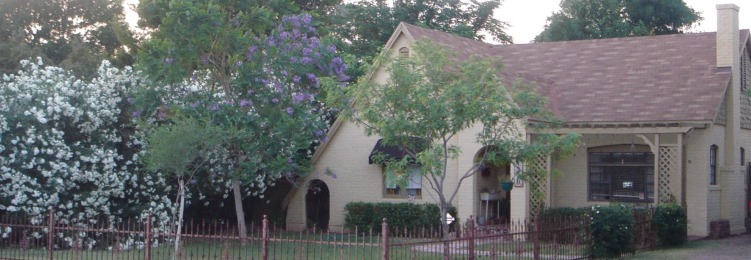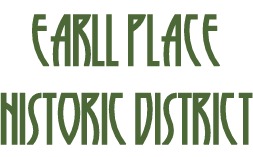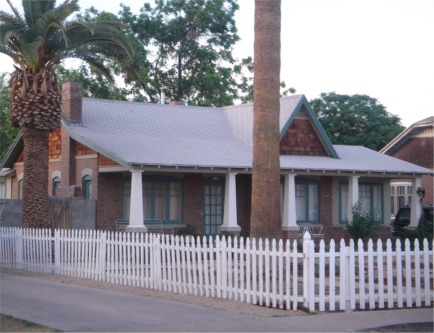 |
 |
 |
|
|
 |
|
|
|

|
| |
|
|
The Earll Place Historic District is a central Phoenix residential neighborhood that
developed predominantly between 1927 and 1930. The district lies two miles north and
one mile east of the historic city center, an area that was on the fringe of the core
development of Phoenix in 1927. The district is comprised of homes fronting on two adjacent,
parallel east-west streets. Pinchot Avenue and Earll Drive, and is one block in length on both streets.
Because most development occurred within the first years of the commencement of the subdivision,
most of the homes in the area represent the styles popular at that time including the late examples
of the Bungalow Style and various types of Period Revival dwellings. Later development included homes
from the Ranch stylistic era. As a whole, the neighborhood retains its historic appearance from its
period of development.
Description
The Earll Place Historic District is located northeast of the major intersection at Thomas Road and
16th Street in central Phoenix. At the time of its development, this area was on the edge of the
developed core of Phoenix, in an area dominated by agriculture but which was rapidly becoming developed.
The Earll Place subdivision as recorded with Maricopa County in 1927 stretched from 16th Street to 18th Street,
and was bounded by the alley north of Earll Drive and Pinchot Avenue. The exception was that lots along
16th Street (excluded from the district) were oriented to that thoroughfare. Alleys were included to service
the rear of each lot. Following the typical practice of the day, the lots are narrow but deep;
these were considered “standard city lots.”
The district is populated by 41 one-story single-family residential properties, many of which have guest houses,
detached rental units, garages, or other outbuildings. With few exceptions, the street front setback is uniform
at 25 to 35 feet from the property line, usually providing a landscaped front yard. Sixty-foot street rights-of-way
include space for planting strips and sidewalks on either side of asphalt-paved traffic lanes provided with concrete curbs.
Architectural styles represented in the Earll Place Historic District are predominantly these popular during
the 1927-1930 development period, although secondary development between 1935 and 1942 also occurred.
Styles represented in the first development period include the Bungalow Style and Period Revival variants,
including the Spanish Colonial Revival, English Tudor Revival, and the Southwest Styles.
Thirty-four of the homes in the district represent the first period of development.
Styles of the secondary development include primarily California Ranch. Homes of the secondary developmental period
number eight. One property in the district was redeveloped in 1979.
The overall condition of the properties in the neighborhood is good. Most homes are well-maintained.
The majority of the homes are unaltered or have minor alterations such as window replacements, or in some
cases exterior sheathing such as stucco applied over earlier brick.
The district is distinguished from its surroundings on all sides. The area to the west, which includes all
of the lost of the original subdivision fronting on 16th Street, has been redeveloped as commercial property
and no longer has a historic character. More modern residential developments border the site on the north,
east and south. Immediately abutting the east side of the historic district , original lots of the
Earll Place subdivision are occupied by vacant land, parking lots, a modern church, and several properties of
both historic and modern age with have poor integrity.
SIGNIFICANCE
Summary
The Earll Place Historic District is significant under Criterion 1 (as set forth in Section 807.D of the
City of Phoenix Zoning Ordinance) in the area of Community Planning and Development as an excellent example
of the northward and eastward development in Phoenix in the 1920s and 30s and the typical development model
that it implemented. The District is additionally significant under Criterion 3 in the area of Architecture
as a neighborhood predominantly displaying home styles popular between 1927 and 1930, mostly Bungalows and
Period Revival homes, as well as later infill development in the Ranch style.
History
Until the 1920s, the area that would become Earll Place remained cultivated for agriculture.
This area was situated between the Creighton District and the Osborn District, two mini farm districts that
utilized water coming from the nearby Grand Canal. Roosevelt Damn’s completion in 1911 brought a dependable
source of water to Phoenix, and instigated a population boom. This in turn prompted some small owners to
subdivide their holdings into smaller residential lots. Phoenix’s population growth slowed substantially in
1914 at the onset of World War I, but increased sharply after the war.
In the 1920s, Phoenix saw unprecedented agricultural and commercial production, promoting another population boom.
The spiraling population increase also affected the physical dimensions of the city, as residential development
rapidly extended the rural-urban interface in all directions from the city center. Meeting the demand for suburban
residential land outside the city, landowners platted 36 new subdivisions in the six months leading up to March 1927.
This expansion included farm lands to the north and east of the city. E. A. Earll subdivided his land north of
Thomas Road and east of 16th Street in February of 1927.
E. A. Earll offered bare lots for sale and also built several houses on speculation. The first house offered
for sale was an English Tudor-style residence Earll built at 1626 E. Pinchot.

By early March 1927, Earll’s builder,
George McGinnis, started construction on three more Tudor Revival and Bungalow brick homes. The large lots,
all measuring a quarter or third of an acre—had soft water pumped to the site. Earll invested in several improvements,
including graded gravel roads, service alleys, and electricity available at the “low suburban rate.”
Children in the district could use the Creighton school district bus.
In February, Earll offered the quarter-acre tracts for $350 and the third-acre lots for $385. The homes had many
modern conveniences: “wonderful kitchen, containing Lasto sink, Hotpoint automatic range, electric water heater,
breakfast nook, etc…Just the place for the discriminating housewife.” A buyer could have this home for $4,750, or a
smaller but similar one at 1681 E. Earll Drive for just $3,900. Homeowners could enjoy “city conveniences and no
city taxes.” By February 1928, Earll had invested $75,000 worth of improvements in the subdivision, and had sold
two homes that he had built on speculation.
Property values in the suburbs northeast of town had risen significantly after the Biltmore interests announced
their plans to build the new two million dollar Biltmore Hotel near Squaw Peak. By March 25, 1928, Earll had increased
lot prices to $395 and up for 50 x 175 lots and $500 for 65 x 175 lots, but he did offer 5% off for cash payment.
Builder C. W. Harvey bought a few Earll Place lots as investments and built the “Spanish stucco bungalow” on the
double lot at 1642 E. Pinchot on speculation, after moving into his own home at 1636 E. Pinchot. By 1930, Earll had
sold all of the lots in Earll Place, although four homes built on speculation remained vacant until 1931.
Earll capitalized on the growing popularity of the automobile as a lifestyle necessity of the new suburbanite.
Earll assumed his customers would be driving to see Earll Place and would need garage space when they moved there.
Most of his homes included detached one- or two-car garages. As the Phoenix streetcar system ultimately failed,
it is just as well that Earll Place residents had so enthusiastically embraced automobile culture.
The stock market crash in 1929 slowed, but did not halt, Phoenix’s growth. Unlike cities in the industrial north and east,
Phoenix’s strong agricultural economy, increasingly diversified business community, and status as the state
government center kept the city alive, but still financially shaken. New Deal programs instituted in the 1930s
helped many people in need, and established government guidelines and procedures that endured through the twentieth
century. However, most of the homes built in Earll Place reflect the style and unique characteristics of the
Period Revival and Bungalow styles of the pre-FHA era of building.
Architecture
Broadly speaking, the architectural styles used in home construction in Phoenix during the 20th century have been
strongly influenced by the fashions of the day. From the turn of the 20th century to World War I, the Bungalow Style
or variants of it were employed for most middle-class residences in Phoenix. After the war (1917-18), American soldiers
returned to the U.S. with a broader perspective on world architecture, and the public began to ask that their homes
be built with reference to the old-world styles they had seen-in Phoenix mostly particularly the Tudor Revival and
Spanish Colonial Revival styles. While Bungalows continued to be built, they acquired certain aspects of the newer,
Period Revival styles as they gradually were phased out, becoming largely extinct by the Great Depression (1929).
All residential building in Phoenix ground to a complete halt after the stock market crash of 1929 and then gradually
picked back up as the country fought its way out of the Depression. These years were, not surprisingly, marked by a
reduction in house sizes, simplification of details and the growth of cheaper construction technologies such as
slab-on-grade foundation systems. This period also saw the rise of the Ranch house, as the Period Revival lost favor.
Earll Place contains mostly English Tudor, Bungalow and Spanish Colonial Revival homes built by E. A. Earll’s builders.
George McGinnis built most of the English Tudor and Bungalow homes in the neighborhood, and contractor
C. W. Harvey built Spanish revival homes on speculation. Earll’s speculative efforts were very successful,
as all of his homes sold within four years, even during the early years of the Great Depression.
Earll’s advertising strategy included the appeal of the suburban “country estate,” exemplified by the charming
cottage exterior and custom wood interior details, while also promoting modern conveniences such as electric light
switches and modern kitchen appliances.
Typical features of the Bungalow Style include single-story massing with large, covered front porches; multiple
gabled roofs of medium to low pitch with broad eaves and exposed, sometimes decoratively cut rafter tails;
the use of massive piers, often tapered, to support porch roofs; and often the use of rustic materials for
wall sheathing such as wood shingles, cobblestones, clinker brick, and pebble-dashed stucco. Development of the
Earll Place Historic District began at the end of the bungalow’s popularity, and only 13 of the district’s
42 homes were bungalows.
The English Tudor Revival Style is marked by high pitched gables, usually front-facing, and stylistic details such as
half-timbering in the gables, arched entryways, arcaded wing walls, and sweeping eaves. Twelve of the homes in
Earll Place employed the English Tudor Revival style.
Spanish Colonial Revival homes employ forms and details to evoke early Spanish architecture in the new world.
Roofs are usually gabled, with tile roofs, and walls are stuccoed. Other details may include round arched openings,
arcaded wing walls, and a combination of flat roofs and pitched roofs. There are two Spanish Colonial Revival
homes in Earll Place.
The Southwest Style is a blend of Spanish Colonial and Pueblo elements. Wall surfaces are stuccoed, and the roof
has predominantly flat roofed forms with occasional tile accents as awnings, porch roofs, or parapet caps.
Porch and door openings have arched details. Six homes in Earll Place are categorized as Southwest Style.
|
|
 |
|
|
|
|
 |
